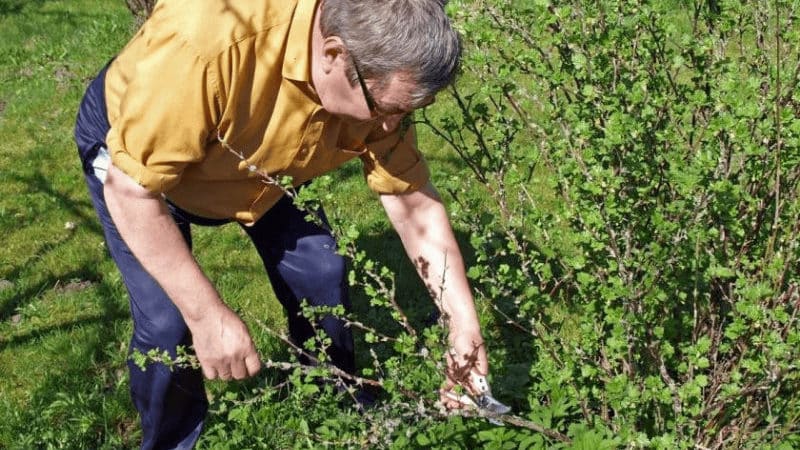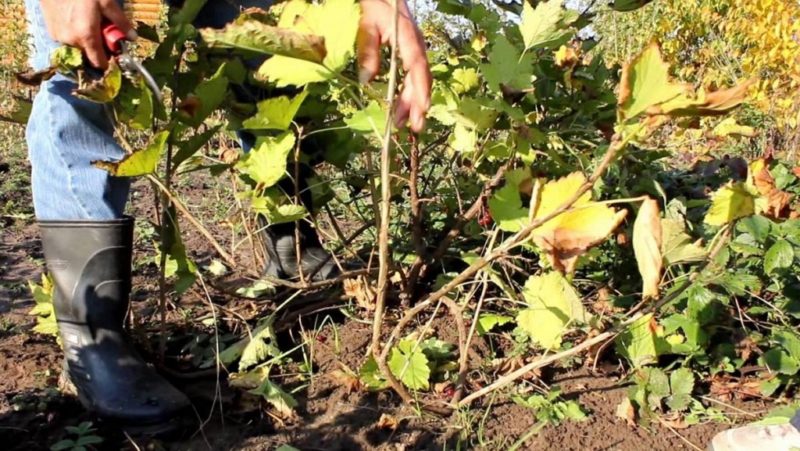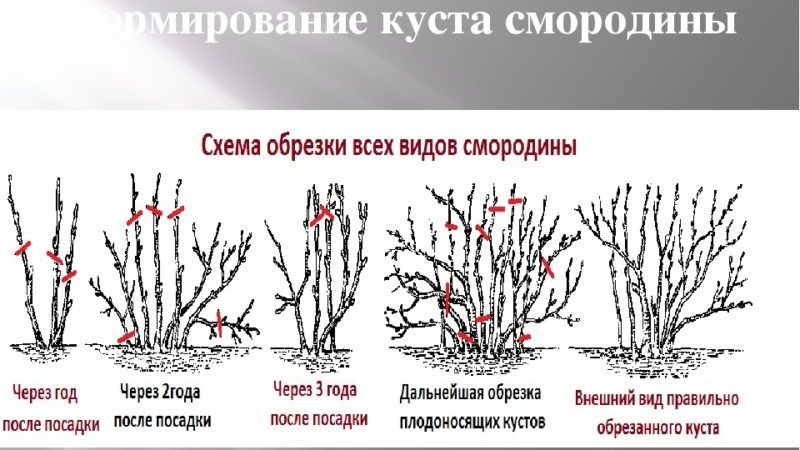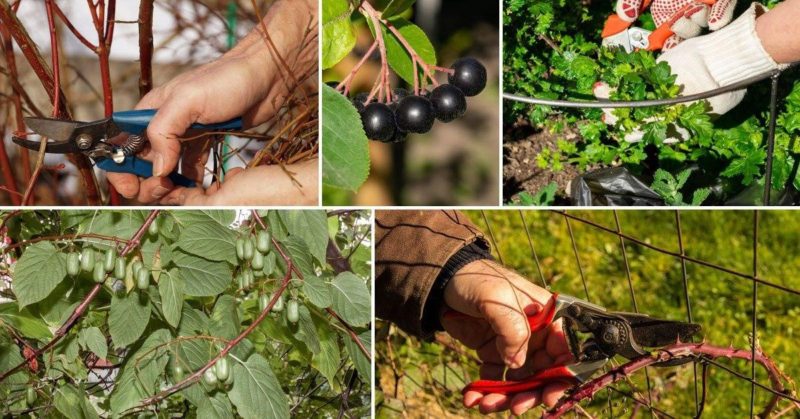Timing and technology for pruning currant and gooseberry bushes in spring, summer and autumn
In favorable conditions, gooseberries and currants bear fruit for up to 20 years. Proper agricultural practices, including regular pruning and timely replacement of old branches with more productive young shoots, maintain the health and fruiting of shrubs. Without pruning, shoot growth slows down, the berries become smaller, and the yield decreases. Let's consider when to prune gooseberries and currants - in spring or autumn, whether it is allowed to do this in the summer and how to carry out the procedure correctly.
When to prune currants and gooseberries

Berry bushes are pruned mainly in spring and autumn. Summer pruning is performed least often. It is believed that in a leafy state it is impossible to properly inspect the frame and trim the necessary branches.
in spring bushes are carefully inspected and dead, dry and damaged branches are removed. The main thing is to be in time before the sap flow begins.
Autumn - the most favorable time of year for this procedure. The plants are in a dormant period or are preparing for it, the skeletal branches are clearly visible, so the risk of cutting off the wrong shoots is minimal.
Pruning currants and gooseberries in spring

Spring pruning of bushes is carried out before the sap begins to flow and buds open - in March - April. The work uses sharp pruning shears with smooth blades to remove growths and shoots. Thick old branches are cut with a garden saw or hacksaw. The instrument is first disinfected in a solution of potassium permanganate or medical alcohol.
The formation cycle of a currant bush is 6 let. The first pruning is performed after planting. The branch is completely removed, leaving 2-3 developed buds. At the end of the first year of development, 5-6 strong shoots should form on the bush.
Next year cut off the branches of the second order and leave 4–8 buds on each of them. The tops of the strongest shoots are pinched. Weak, diseased, thickened annual shoots are completely removed. In the third year, perennial and strong annual branches are shortened, leaving ⅓ of the length.
In 2–5 years, at the peak of fruiting, 10–15 perennial branches are left on a properly formed bush. Old but still fruiting shoots have their ends cut off with weak growth.
For 6-7 years It is recommended to prune branches older than 5 years to the base. The procedure is performed gradually over 2-3 years. It is important to wait for strong young shoots to appear. If you cut off all the old branches at once, the bush will die. Old branches of black currant are recognized by their brown bark, weak growths, length up to 10 cm, underdeveloped buds and dry fruit branches.
In the future, the condition of the bush is maintained by cutting according to the standard pattern.. Old and fruit-bearing branches are cut off, leaving young and strong shoots.
The skeletal branches of white and red currants, unlike black currants, are more durable. Old branches are removed completely 7-8 years after planting. Weakened ones at the age of 5-6 years are rejuvenated by pruning into lateral branches.
Most fruit buds are formed on annual growths, so they cannot be cut. Otherwise, the quality of the harvest next season will decrease.
Reference. Many varieties of red and white currants are prone to intensive formation of basal shoots. Such bushes need more careful thinning.
The gooseberry variety Smena short-lived skeletal branches, so it is pruned in a similar way to black currants. The more durable Yubileiny and Russian varieties are pruned 7-8 years after planting.
Often used for gooseberries rejuvenating and thinning pruning by analogy with the scheme for red currants. Spring is considered the ideal period for the formation of bushes. The procedure is performed before the buds open or is partially postponed until autumn. In the spring, diseased and damaged branches are carefully pruned, and in the fall, old and thickening branches are removed.
It is not recommended to leave stumps after pruning, as they become an ideal place for overwintering insect pest larvae. Gardeners advise removing branches to the base. In addition, top shoots grow on the stumps, which impede the growth of zero ones. In thickened gooseberry plantings, remove damaged, dry and weakened branches.
This is interesting:
Why do gooseberries turn yellow and dry in summer and what to do about it?
Where is the best place to plant gooseberries in the garden?
Spring pruning helps:
- rejuvenation of aging currant and gooseberry bushes;
- the flow of minerals to the ovaries;
- reducing the risk of infection by fungal spores;
- proper formation of young shoots;
- increasing productivity.
There is only one drawback: if you perform the procedure during the period of sap flow and the formation of fruit buds, you can partially or completely lose the berry bushes.

How to prune in the fall
Autumn is the most favorable and safest period for trimming berry bushes. The buds on them begin to bloom in early spring, when the threat of return frosts is high. In autumn, pruning is carried out without fear and old, damaged, diseased and fruit-bearing branches are removed without loss of productivity. During this period, sanitary pruning is often performed.
Benefits of the procedure:
- full examination of the bush skeleton;
- the plant is dormant and tolerates pruning more easily;
- access to all branches;
- the possibility of combined pruning and preparation of cuttings for planting next season.
Scheme for autumn pruning of berries:
- damaged, old and broken branches are completely cut off with a sharp tool;
- remove all thickening branches;
- 5-6 one-year, 4 two-year, 3 three-year, 2-3 four-year shoots are left on the bushes.
In total, there should be 20–25 strong branches left on the bush. Autumn pruning is suitable for winter-hardy and low shrubs that have the opportunity to spend the frosty months under snow cover.
Summer pruning of currants and gooseberries

Summer pruning is performed to remove underdeveloped branches that take additional nutrition from the plant. Without the necessary minerals, the berries grow small or do not appear at all. Allowed in summer gooseberry pruning for removing damaged (5 mm from the base) and diseased shoots.
To obtain a high-quality gooseberry harvest, it is recommended to collect part of the berries (when they reach ¼ size). Pruning improves the growth and development of the bush, helping to form its neat shape up to 55–60 cm in diameter.
Gentle pruning of gooseberries is carried out in mid-July, after fruiting. This will help reach the berries inside the bush and speed up their ripening due to access to sunlight.
Important! In August, more serious pruning is performed - all broken and diseased branches are removed under the base. After this, intensive growth of young shoots begins, which are used for propagation in the next season.
Pruning currant bushes start in the year of planting: select 3-4 strong and healthy shoots, cut to 2 or 3 buds, the rest are completely removed.
Two-year-old currants are pruned at the end of July.. The branches are shortened by 2 buds, but not more than 10 cm. The procedure is carried out to form lateral shoots and stimulate the development of underground buds. Additionally, side branches growing horizontally or downwards are cut off. They interfere with the proper formation of young shoots and fruit buds.
The rules for pruning three-year-old currants correspond to the procedure for two-year-old bushes. Young annual shoots and branches growing inward are cut with sharp pruning shears. At the same time, shoots that thicken the bush are removed.
Five-year-old currants are pruned after harvesting.. Mature bushes are pruned at the end of July - beginning of August, after fruiting is completed. To do this, use the following scheme:
- cut off annual shoots, except 3-4 promising ones;
- pinch annual branches 10–15 cm for better development;
- shorten lateral branches aged 2–4 years with 4 buds;
- Five-year-old branches are completely cut off at ground level.
It is advisable to combine sanitary, formative and rejuvenating pruning of currants and gooseberries in order to simultaneously prepare cuttings for propagation.
Red and white currants have similar bush structure and fruiting. Their branches are considered old when they are 7-8 years old, and the peak of fruiting occurs at the age of five.Summer pruning of white and red currants is carried out at the end of July, after harvesting.
It is recommended to follow the following scheme:
- cut off all internal young shoots, shade fruit-bearing branches;
- 2-3 year old shoots are not touched;
- old and fruit-bearing branches are completely cut off;
- zero shoots growing from the ground are cut off or dug in to obtain layering;
- dry, damaged and diseased branches are completely removed.
When pruning in summer, the direction of shoot growth is set and the bush is formed correctly. This improves the ripening of berries.
The disadvantage of the procedure is the likelihood of removing shoots that have a high potential for fruiting in the next season.
Conclusion
Pruning berry bushes is one of the most important stages of agricultural technology, helping to maintain the health and fruiting of plants. The procedure is performed in spring, summer or autumn, depending on the goals. In the spring, before sap flow begins, frozen, diseased and damaged branches are removed. Spring pruning promotes the rejuvenation of aging bushes, the supply of minerals to the ovaries, reducing the risk of infection, and the proper formation of young shoots.
Summer pruning of currants and gooseberries is carried out to remove underdeveloped, broken and diseased branches. In autumn, the procedure is performed after harvesting, when the plants are in a dormant period and can more easily tolerate damage. Sanitary pruning is often combined with the preparation of cuttings for planting next season.